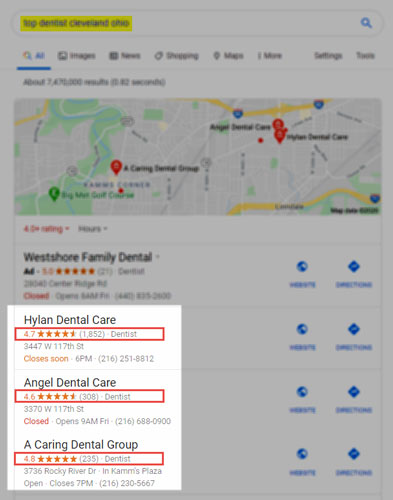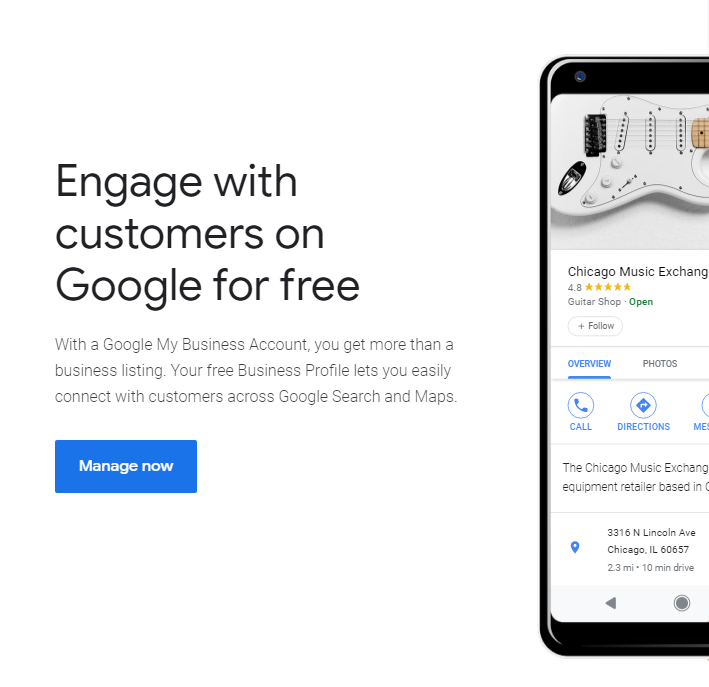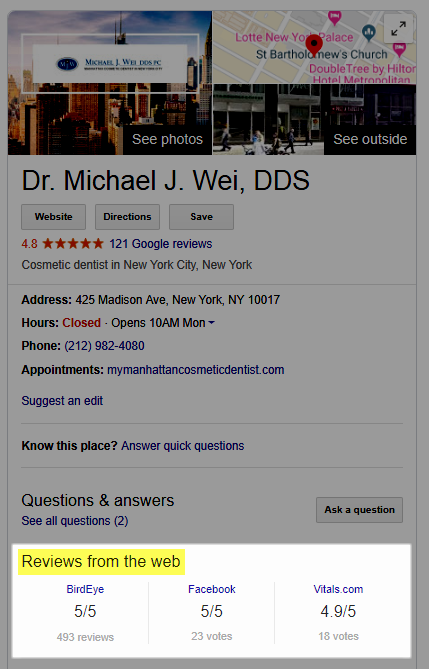Boost Reviews, Reduce Poor Experience, Win new patients
This guide is for the proactive business or practice owner who wants to earn trust online, maintain trust in real life, generate more positive feedback, and reduce negative feedback. We will cover concepts related to online reputation management (ORM), definitions, and strategies to help you stay ahead of the competition.
After reading this guide, you will have a much better understanding of online reputation management. You will also know how to manage, monitor, obtain, and refute online reviews.
CHAPTERS
DEFINING REPUTATION MANAGEMENT
What is Online Reputation Management?
GETTING STARTED WITH ORM
Audit Your Reputation and Take Action.
MANAGING SOCIAL MEDIA & MORE
Managing Your Social Presence Effectively.
HANDLING NEGATIVE REVIEWS
Dealing With Negative Reviews.
MAINTAINING PATIENT LOYALTY
Keep Your Customers and Patients.
GUIDE – REPUTATION EBOOK
Grab Our Easy-to-Follow Guide Now.
WHAT IS ONLINE REPUTATION MANAGEMENT?
Online reputation management (ORM) is the strategy used to proactively control reputation on the web. ORM includes obtaining positive reviews from patients, monitoring review websites and social media, and addressing neutral or negative reviews.
Why ORM Matters
You may be the best dentist, cosmetic surgeon, hair transplant expert or general practitioner in a 45-mile radius. However, if even one person has a negative experience with your practice, a negative review can appear online.
To the many strangers that read the negative review, it doesn’t matter how good you think you are. There must be a mostly positive sentiment of your performance abilities, products or skill on the web to convince potential customers or patients.

How ORM Matters
Online reputation will directly impact your bottom line. No one wants to do business with a company that has poor ratings online. In a world where online is forever, the worst thing you can do is to not take control of your online reputation.
Be proactive and do not wait until you receive negative reviews.
You Are Your Reputation
Do you know what that reputation is? It is in the stars.
Literally.
When you have a business, ‘stars’ become very important. The more stars you get through reviews, the better! But how to you make sure you get the best reviews possible?
There are countless medical practitioner review sites throughout the internet, and your patients have access to any one of them. Some of these sites include HealthGrades.com, Vitals.com, Wellness.com, and RealPatientRatings.com. But why should you care? Reviews are subjective, right?
“..94 percent of Internet users who have visited a doctor reviews site consider the reviews useful.”
Yes, but they do matter. According to ReviewTrackers.com, “A staggering 94 percent of Internet users who have visited a doctor reviews site consider the reviews useful.”
Taking that a step further, bad emotions and feedback have more impact than good. Negative reviews are also processed more thoroughly than positive ones. The key to encouraging positive patient feedback is simple: provide excellent care with a thoughtful attitude.
Train your staff to do the same. Give your patients every reason to leave great feedback and no reason to to leave negative posts.
If a patient has just one negative experience at your office and decides to complain about it on social media, that complaint can be seen by hundreds (or more) people. You don’t have to be a Kardashian for your negative post to be seen and shared.
People like to share and comment on things – especially negative things. It is safe to assume that all perspective patients will be searching for reviews before they make contact with your business.
Don’t let poor reviews or articles become a sticking point, because it will directly impact your bottom line.
Negative reviews will also impede any other marketing efforts, as the last action a potential patient will take before making contact is looking up reviews.
“Negative reviews will impede other marketing efforts.”
Reputation is everything. In our digital age, it’s easy to learn a lot about a doctor and a medical practice by doing a simple Google search. A BrightLocal study in 2016 found that 85% of consumers “trust online reviews as much as a personal recommendation.
” On the internet, anyone can find the good, the bad, and the ugly with little effort. Negative reviews may cause people to turn away before they even step foot into your office. A positive review, can create confidence and inspire people to contact your office.
Software Advice found that roughly half of patients are willing to look outside of their insurance network for a reputable doctor. We see overwhelmingly that reputation matters most. This is especially true for high involvement purchases or cosmetic procedures.
We all want the best. Make sure your reputation sells.
Reputation Management Guide
Grab Our Offical eBook
PART 2: GETTING STARTED WITH ONLINE REPUTATION MANAGEMENT
Three Rules of ORM
People Talk
People are talking about you online, even if you don’t know about it. Patients may already be posting reviews on different websites or talking about you on social media.
Branding Matters
From awareness, to loyalty, and affinity. Reviews do more than earn you stars. They help build a brand that reflects your unique value and core competencies.
You Can’t Fake It
Sometimes, negative reviews speak the truth. If a process is broken, you need to fix it. Don’t fake it or fool yourself into believing everyone else is wrong. It won’t work.
Improving your online reputation management doesn’t have to be a daunting task, even if it can seem that way.
Want to find reviews that already exist and quickly? Do a Google search on yourself or for your practice name.
Want to know when you’re mentioned online in the future?
Create a Google Alert.
The more relevant and useful resources connected with your brand name, the better. Make sure you also have official pages on social media for your practice as well.
The Gold Standard: Your Google Business Profile Listing
Your Google Business Profile listing is a free listing that appears when users search for your business.
The business listing is usually auto generated by Google using public data from the web. At times, the data in the listing is not always accurate.

As a first step, review and correct any errors in your listing. To do this, you must first claim ownership of the listing.
If you are not sure whether you have a Google Listing, search for your practice name on Google.
If a listing does not appear on the first attempt, try including your city name or specific location.
Still no Google listing?
Click here to create one from scratch, or let us handle it.
INDUSTRY INSIDER TIP
Several companies provide business listing discovery and optimization services. Generally, they will provide a free crawl of the web and generate a report with results. This is an easy and free way to see if you have a Google listing, and to see if other listings on the web are accurate!
Check your online listings for free:
Moz Local: https://moz.com/local/search
Google Business Profile
Believe it or not, Google accounts for website authority and tends to highlight reviews from well established websites in your practice listing.
Reviews posted on WebMD and Healthgrades can make their way into your Google Business Listing.
See the example below.

Positive Reviews Can Improve Your Google Rankings
Google loves to recommend businesses that are reviewed favorably online.
Authority, relevance and popularity matter when it comes to your online reputation and your local rankings on Google. All else equal, positive reviews can help increase your visibility in Google’s local map pack results.
The map pack results appear on the search results page.

Google prefers to show higher quality websites and practices. Better reviews mean better potential visibility; better visibility means more website visitors; more website visitors mean more potential leads.
Simply put, obtaining positive reviews can help boost your local rankings and reputation.
How to Get Real Reviews
Unfortunately, there is no easy way to obtain reviews for your practice.
However, you can create an automated system to inform, encourage, and remind your patients to post a review online.
Keep in mind that Google can practically read minds, it’s safe to assume they can also tell when a review is fake. Do not have your staff leave reviews. It will look unprofessional and may not be taken lightly by certain platforms, such as Yelp.
Below are some ideas and strategies for generating more online reviews.
1) Ask!
Repetition is retention. Ask, ask, ask!
If patients are satisfied with your work, request that they leave a review from their device while still at your office. Asking personally is very effective at lighting the flame.
According to ReputationStacker.com, seven out of 10 customers will write a review if they’re asked to do so.
2) Use Handouts
No, not free stuff. (We’ll touch on that later.)
In this case, handouts are reminders for patients to review your practice online. They can be as simple as a business card handed out at the front desk or directly from you! Handout ideas:
- Business card-sized information/reminder cards with some site options where they can leave feedback.
- Printed thank-you cards (that you personally sign) with a reminder to review the practice online.
- Included on your brochures and other marketing material.
These items can be placed in go-bags at dental offices, etc., or be handed to individuals at checkout. Again, this is just one touch-point that helps plant the seed. You may still need to follow up.
INDUSTRY INSIDER TIP
Hand the card out yourself!
If you explain to your patients how reviews can help and personally offer them a reminder card, they’ll probably be more than happy to help you. This also allows you to target patients who are likely to leave glowing and detailed reviews.
Personal Emails or Text Messages
Make sure you follow up with a personalized email or text. When doing this, you can reduce friction by providing a link directly to one of your online review profiles, such as Google Business Profile, Healthgrades, Vitals, etc.
This method can also be automated to improve workflow through services such as RepCheckup.com. We can handle the setup and monitoring of this automation tool.
Cross-Posting Reviews
If a satisfied patient left a review on one platform, reach out to him or her and request they leave a similar review elsewhere. This is low-hanging fruit!
Incentives for Reviews, Yes or No?
First, we don’t condone the use of paid or fake reviews. To be authentic and therefore trustworthy your reviews should be organic, no matter where they are posted.
That being said, there are businesses and practices that provide incentives for reviews. These may include free products, discounts, gift cards and other prizes.
While incentives may encourage patients who might not normally leave reviews, they may also lure others who just want a free gift, leading to a weak review profile.
Furthermore, you can get penalized by the platform for breaching their terms of service. Make sure you review the terms closely before taking action.
We know of practices that do offer incentives to reviewers. If you plan on doing this, follow these basic guidelines:
- Reviews should be detailed and include information that?s helpful to others. No two-sentence 5 star-reviews!
- It’s preferable for the reviewer to have a solid review history on the platform they’ll use.
- Do not solicit reviews using a machine or device located in your office.
Review velocity matters. Don’t aim for a ton of 5 star reviews in a short period of time. It’s best if they are spread out.
Reputation Management Guide
Grab Our Offical eBook
PART 3: SOCIAL MEDIA
What Social Media & Your Website Say About You
You have a website, a Facebook page, and a YouTube channel. You also have a Twitter account, but you only use that for personal stuff. You should be good to go, right?
Maybe. But probably not.
Ask yourself the following questions (we provided some example answers):
- This method can also be automated to improve workflow through services such as RepCheckup.com. We can handle the setup and monitoring of this automation tool.
- Is my practice information listed and correct?
Does any of this sound like you?
“My website guy (my nephew) takes care of my site. I’m pretty sure my front desk person sent him our new office hours. I rarely go to LinkedIn, and I have no idea about my practice’s Facebook Page? I never check it.
YouTube? I think we have only two or three videos from a few years ago.”
If people find your website, they should see a site that’s easy to read and navigate. Your business information (name, location, contact information, how to schedule, etc.) should be prominent. A photo of your office from the outside is also helpful to them.
Your site must also be up-to-date. If your site was last updated in 2013 and says as much, what type of authority are you projecting? As Edward De Bono said,
“Perception is real even when it is not reality.”
All of this goes for social media, too. Don’t create profiles for the sake of having profiles. Focus on those you can, and will use.
Which Social Media Platforms Should I Use?
You don’t “need” to be on any, but if you want to connect with people where they are and can easily find you, Facebook is still a great way to go. SproutSocial.com’s “2019 Social Media Demographics for Marketers” says that the site as 2.27 billion monthly active users, with close to 1.5 billion of them checking their accounts every day.
That means Facebook has become a daily part of their lives. Facebook also owns Instagram, so you can link the accounts if applicable.
Another site that offers wide reach is YouTube, the world’s second largest search engine. As a video-sharing site, YouTube is much more intensive than the others. You’ve got to post videos, and they’ve got to be good. Many practices use the platform for video testimonials and advertising.
Quality video doesn’t necessarily mean high-end production. It means solid content. If you attach your smartphone to a tripod and record yourself explaining how to do a specific stretch to alleviate tension headaches, that’s good-quality content.
Of course, the content should be dictated by your audience and your specialty.
In a number of ways, it’s great to have visibility – and freebies like social media accounts can make a huge difference. But you must know and understand each social platform before you attempt to take advantage of these “free” services.
Because while there is no charge to use them (unless you?re going to use paid advertising), it will cost time and effort. That time and effort could be yours, one of your team member’s, or that of someone you hire to handle your social media.
With that in mind, you want to make sure any social media platform you use is a good fit for what you and what you want to accomplish.
Get to know the platforms before making a decision.
If you have a website, blog, YouTube channel, social media presence, etc., they must be kept up-to-date. If they are, great! If not, set up a content plan for posting and assign a staff member to manage your social media.
Social & Personal Privacy
Privacy settings exist for a reason. They?re on every social media platform. Use them.
Below are links to privacy settings for popular social sites:
Regarding Facebook, keep in mind this site is set up to be for both personal and professional use. Make sure you have a Facebook page for your business and treat it separately from your personal account.
PART 4: DEALING WITH NEGATIVE REVIEWS
It happens.
Humans have high expectations.
When those expectations are not met, the likelihood of a negative review increases. In fact, people are generally more motivated to leave a negative review than a positive one!
Keep in mind that not all negative reviews come from direct experience with the doctor. The entire office visit – from the front-desk greeting, to the state of the waiting room or examining room – can trigger a negative review from someone.
But even if you get a negative review, it?s not the last word. You can address the review as well as the person who left it. Handled well, a negative can turned into a positive.
HIPAA – Keep it in Mind
HIPAA is complex and we are not legal advisers. However, it makes sense to avoid any mention of procedures or privileged info in an online response.
If possible, try to follow up with the unhappy patient offline via a phone call or by inviting the patient to speak with you in person. A personal interaction is the most likely course to a positive outcome.
Speak Directly With Disgruntled Patients
If the patient leaves a poor review, try to reach out via a phone call or personal email. Talk through the issue and see if you can resolve or communicate misunderstandings.
Best case scenario, they update their review to a positive one.
Respond Quickly & Professionally
It is important to monitor review websites. This allows you to catch negative reviews as soon as they are posted. There are a variety of paid tools that can do this, but you can also monitor review sites manually. Majority of review websites allow the business to respond.
Make sure your response is not accusatory or filled with excuses. Own up to mistakes, but inform the public how you will improve the process or prevent them from occurring in the future if you cannot get the review removed.
Can You Request Review Removals?
Removal requests aren’t approved for just anything. Each site, whether a review site or on social media, has its own guidelines. Were you or anyone else in the practice attacked personally?
Are there cleverly disguised four letter words?
Google and most other platforms have policies that guard against this sort of behavior. In this scenario, you may be able to flag the review for review and removal. Here is a list of prohibited speech in Google reviews:
- Advertising
- Spam
- Off-Top Reviews
- Profanity
- Personal Attacks (Naming and Shaming)
- Conflicts of Interest Hate Speech
INDUSTRY INSIDER TIP
It can be difficult to manually monitor the web for al mentions of your brand. Several tools, such as Mention, make brand monitoring easy.
Negative Press and Online Articles
Negative material may not always take the form of an online review.
A story about your practice or employees may get picked up by the local press. It is also possible for a blogger to write an article and publish it to the web. In the worse cases, we have also seen disciplinary board actions appear in the search results.
Google’s policy regarding removal of this content is extremely strict. There must be a clear violation of their policy, copyright infringement, or a court order for internet defamation.
Rather than spend thousands of dollars on a lawyer, many business opt for “review suppression.”
Review suppression is a strategy where the negative review is buried by new, more relevant and positive reviews. This helps “suppress” or push down the negative online article from the first page of Google (hopefully to the second page and beyond).
This strategy and its associated tactics are not easy to implement, and they may not work for you.
There are many variables at play, such as the level of authority producing the negative content. Even if you cannot bump the negative content from the top spot, it is very beneficial to display positive articles beneath the negative one.
Review suppression is a technical topic that requires a strong understanding of search engine optimization (SEO) and PR. We can walk you through the process.
Online Reputation Management Services
You may want to consider paid review management and monitoring software if you have multiple locations and a large staff.
Most reputation management software automatically aggregates ratings and information from many different places on the web. When a new review is posted, the software sends a notification for easy monitoring.
When it comes to selecting a service, there are a number of key features you can look for:
- User interface
- Connectivity
- Scalability
- Automation
Today, we expect most platforms to provide a flawless user experience. However, not all platforms are created equal.
Connectivity speaks to how well the software integrates with email and notification features. Is it easy to send and receive messages? Adding more practice locations and information should be a simple task. Make sure the platform can easily scale with your business.
Lastly, automation should be one of the biggest factors. Can the platform automatically send out messages to previous patients? Is there a vetting process in place to ensure only qualified individuals will leave a review?
PART 5: MAINTAIN PATIENT & CUSTOMER LOYALTY
Keep Them Coming Back
Positive reviews are important in convincing potential leads of your true value. They also help Google rank you accordingly in their search results.
There are several ways to gather reviews, but the two most important elements needed to success are consistency and selection. By strategically requesting reviews from patients who appreciated the quality of care, your online reputation will benefit.
While a great marketing program will move potential patients through the first three stages of the funnel, your personal service is what will help increase loyalty, positive reviews and advocacy.
GET OUR OFFICAL ORM GUIDE

Contact Us for The eBook!

